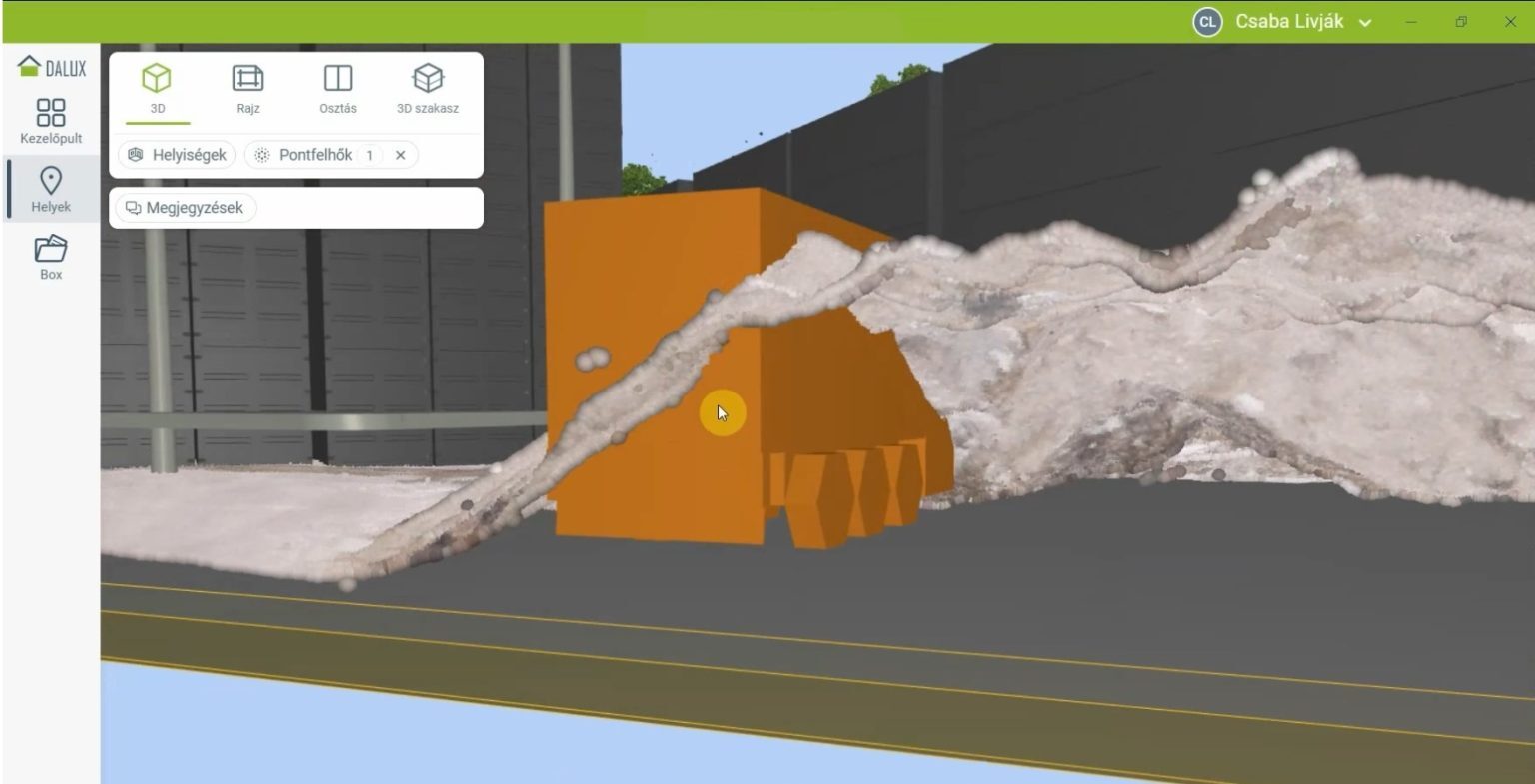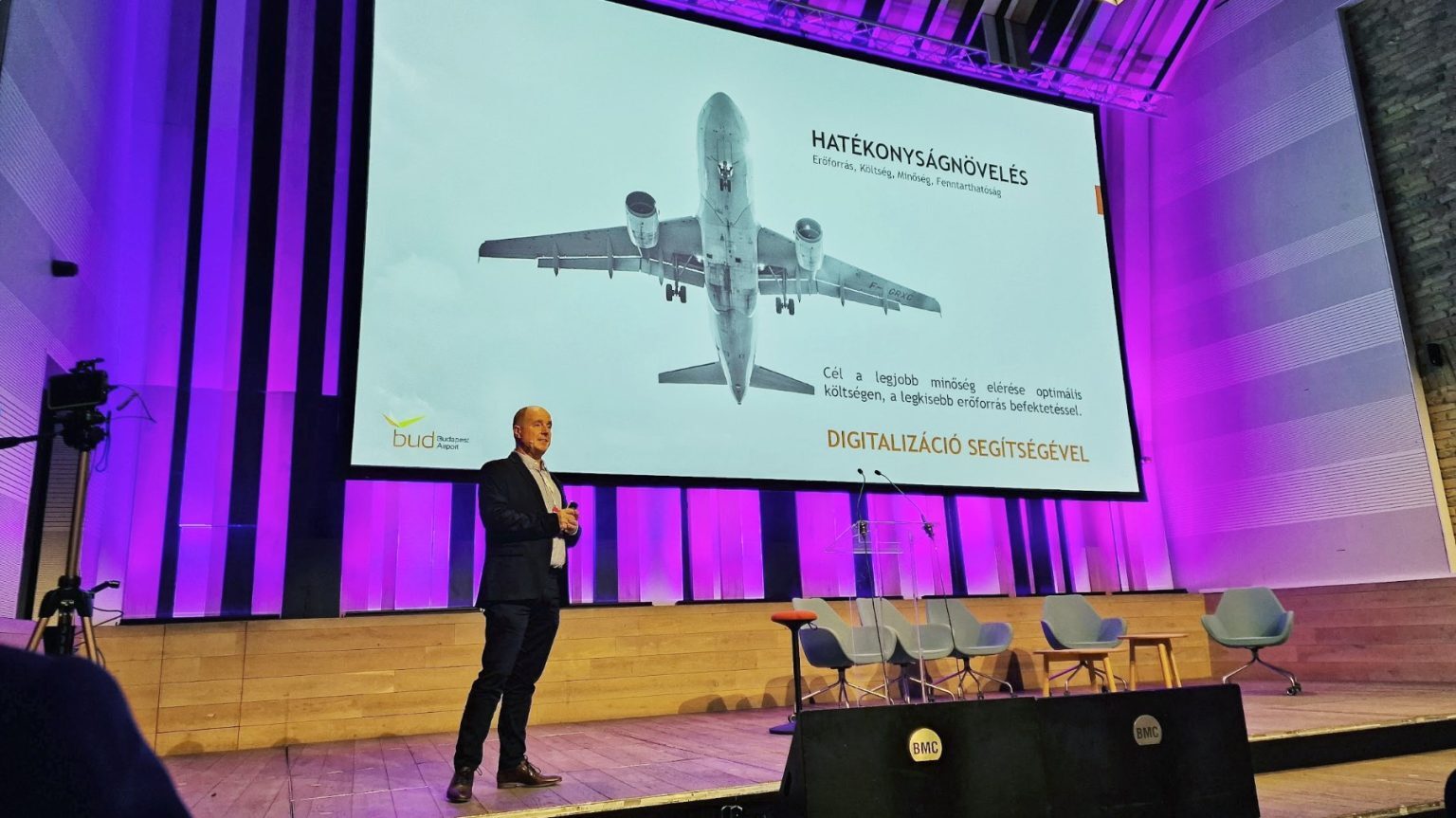Innovation in the Real Estate Market
At the intersection of AI, BIM, sustainable operations, and the uncertainty of construction industry stakeholders, Proptech Hungary’s fifth innovation event unfolded on May 16 at the Budapest Music Center. Report.
In beautiful sunshine, with a true international star line-up, the Proptech Innovation NOW conference kicked off. The morning session was opened by James Dearsley, a returning speaker of the series, with his interview series featuring major innovators of the global real estate market. His unique examples and case studies were followed by a presentation from Dirk Paelinck, founder of Proptech House, who spoke about the EU taxonomy summarizing European proptech organizations and the new European Bauhaus. He was succeeded on stage by Andrew Knight, head data analyst at RICS, who emphasized the growing role of AI throughout the entire real estate value chain.
Dirk Paelinck, CEO of ProptechHouse (Photo: Balázs Glódi)
Fahad Al Tomaihy, founder of Saudi Tayaqan, spoke about the Saudi supercity – a 170-kilometer-long, 200-meter-wide, 800-meter-high smart metropolis imagined in the desert – and its reality. “As a digital twin, the entire city already exists,” he said, standing under a massive Unreal Engine logo. “It only needs to be realized. Many companies are working on it; if you check the NEON project website managing The Line, you’ll see we’ve broken it down into many sub-projects.”
To the layperson, The Line seems more like a location from some exotic sci-fi set in the distant future, and truth be told, Fahad began his presentation with the skepticism he often encounters. The goal is to build a fully self-sustaining, zero-emission city. While opinions differ about its usefulness, one thing is certain: such an ambitious project would bring countless building solutions, so far only theorized, within reach. And although this was undoubtedly the most astonishing presentation of the day, fortunately it does not mean the achievements of modern architecture are only accessible to the super-rich entrepreneurs or rulers of faraway countries.
AR, VR, BIM, AI
The more than 250 conference visitors could attend presentations or workshops in three rooms, while in the main hall companies demonstrated their latest solutions.
“We no longer build plans, we build virtual buildings that can be brought to the construction site or into facility management through the camera of a simple phone,” said Csaba Livják, founder and managing director of BuildEXT Ltd., holding a tablet running the AR application of Dalux’s web-based project platform.
With just three clicks, within seconds he loaded the ground floor plan of the Budapest Music Center, the planned interior design, and, aligned to the visitor’s position, showed the systems inside the walls through the phone’s camera.

Csaba Livják, Managing Director of BuildEXT (Photo: Balázs Glódi)
This is the next phase of construction digitalization. Designers are no longer only responsible for design, but as digital integrators they create the digital twin of buildings in virtual space, connect web project platforms, and enable faster and more efficient communication, information access, and change tracking during design, construction, and operation.
The designer’s responsibility no longer ends with delivering “drawings.” As a digital integrator, they maintain the building’s information model throughout its life cycle. They build it during design, track changes during construction, enrich it with data, and over the next 20 years ensure it remains up-to-date.
This basic idea connects to countless new services, opportunities, and synergies: from AR solutions on phones replacing paper plans, to VR and mixed-reality headsets, simulations, IoT sensor integration, and digital twin technologies.
The result is a new world where construction time is shortened by months, conflicts are reduced to a fraction, and construction and operating costs drop by 20–30%.

Everyday surreality at BuildEXT’s office (Photo: BuildEXT)
A striking example during one presentation showed a wall structure nearly impossible to build with traditional methods, where a master builder was guided by a Hololens mixed reality headset, allowing him to see both reality and exactly what needed to be built.
At the same time, standardization is essential. Through practical examples, we saw the “growing pains” of the industry, how difficult and unsolvable it is to build complex or large-scale projects with traditional tools – but also that there are ways to do it right.
Hungary’s construction digital strategy and the mandatory BIM investment law, later presented by Secretary of State Regő Lánszki, are both pushing in this forward-looking direction.
Left behind if you don’t adapt
The solutions exist, the infrastructure is in place, and digital tools can accompany projects from early needs assessment through design to construction. Still, a recurring theme was that stakeholders often hesitate to implement them – either due to a lack of resources or simply insufficient know-how.
“My goal is to accelerate the digital transformation of the real estate market,” emphasized organizer Zoltán Kalmár in his opening speech, adding, “This conference is an important milestone to bring construction and real estate closer together.” After four previous events, one might think it’s difficult to bring something new, but according to Zoltán, their fifth event also carried a strong message and goal. As the conference’s motto (“Today’s innovations, tomorrow’s challenges”) suggests, innovations are already here, but we must recognize and learn to take advantage of them.

Zoltán Kalmár, CEO of Proptech Hungary and organizer of the event (Photo: Balázs Glódi)
“Industries operate at different paces,” said Csaba Livják, Managing Director of BuildEXT. “I used to be a site manager. I see and know the so-called analog construction industry well. But the world has evolved, and in recent years a digital – even virtual – construction industry has emerged, which is also inevitably breaking through in Hungary.” Csaba not only discussed the potential of BIM but also the benefits of rapidly advancing AI tools.
We even got a glimpse into BuildEXT’s summer children’s camp project, where kids received a direct message from NASA through a digital avatar: to design a space station on a newly discovered, terraformable planet. From the children’s plans, after a week of concept creation, a breathtaking visualization was generated in just 2.5 hours using Midjourney’s AI image generator. “We’re far past the balsa wood architectural models of university days…”

Space station generated with Midjourney at BuildEXT summer camp (Photo: BuildEXT)
Catching up digitally
Artificial intelligence is now as common a buzzword as the multifaceted “digitalization,” but its use is changing work methods so quickly that hesitant or reluctant market players already find themselves at a disadvantage.
Equally significant is the leap provided by lidar imaging devices. Several presentations showed buildings and sites surveyed with geospatial tools that, even in virtual space, contained enough data for architects, engineers, and contractors to work with. A client asks: can construction proceed on a plot filled with sand piles and garbage? A drone and some hi-tech expertise are enough to deliver the answer.

Of course, merging industries wouldn’t be complete without public sector involvement. At Proptech Innovation Now, Regő Lánszki, Secretary of State for Architecture at the Ministry of Construction and Transport, also gave a talk. “Hungary must catch up with the digital frontrunners, and there is still room to improve, since in the EU’s Digital Economy and Society Index, Hungary ranks 22nd out of 27 member states… Research suggests that in the coming decades, nearly half of Hungarian jobs will be at risk from automation created by digital transformation.” He stressed that although digital literacy among the population is not outstanding, the real barrier is businesses’ low level of digitalization. Catching up digitally is therefore an essential economic interest.
Of course, declaring the need is one thing; convincing the market to invest is another. In a roundtable discussion, Tibor Massányi, Managing Partner of DVM Group, emphasized the importance of education: “This is the primary task, because without showing industry players the real opportunities in digitalization, no tangible results can be expected.” “We work in a very cost-sensitive market, so the question is why BIM models are needed in operations, and who pays for them,” said Gábor Décsi, CEO of Dome Group Hungary. He argued that energy is the area where such investments can pay off, giving facility management a highlighted role. At the same time, from the client’s perspective, no prior expertise is required: “We have a client who wrote on a piece of paper that he wants to operate a digital factory in Hungary. It’s not about BIM expertise or demonstrable experience, but the ability to innovate and find a partner to build digital, BIM-based operations with.”

The world of advanced digital strategies
The conference was also strengthened by companies with the most advanced digital strategies in Hungary. Representing Budapest Airport Zrt., Gergely Bedő, Head of Buildings and Constructions, introduced us to the world of international airports and BUD’s digital strategy.

Gergely Bedő (BUD) presentation (Photo: Balázs Glódi)
This was followed by a closed BIM roundtable featuring Bosch, LEGO, and the University of Pécs, with Izabella Gazdusné Wusinczky, Zsigmond Bakk, and Dr. Márk Zagorácz sharing practical experiences, the culture of mistakes, challenges, and results.
The conclusion: careful preparation and planning repay a hundredfold, but a successful BIM project can only happen when demand is generated by the client or operator side and is met by the designer, contractor, and operator.
The culture of “covering your ass”
The professional knowledge and necessary technology are there. Sure, investment is never cheap, but the benefits are many, so it can pay off. So what is the world waiting for? Co-host Gábor Bazsó, alias Karotta, described the problem best: what he called the “culture of covering your ass” – that no one wants to innovate because they fear risking their long-standing business model or position. The reality, however, according to most experts, is the opposite: industry players are already generating less profit due to insufficient digital maturity, and the longer they wait, the harder it will be to catch up.
Karotta’s talk, by the way, was about the current state of electric cars and their general misinterpretation. Although the press often writes that the transition has lost momentum, the automotive journalist insisted this is a misunderstanding: it’s merely the growth of the transition that is slowing down.
In his sharp style, he responded to criticisms of e-mobility: showing oil rigs, he pointed out that oil doesn’t just appear at gas stations; it has to be transported there. Complaints about infrastructure are really about the fatigue of transforming existing systems. Generating electricity locally is neither difficult nor less sustainable; the world has simply gotten used to fossil fuels, and it’s easier to cling to the old mantra than admit it’s no longer efficient.
Still, there is clearly demand for change. The conference atmosphere was generally hopeful, with visitors frequently mingling with each other and exhibiting companies. Whether the connection outlined by Zoltán will materialize remains to be seen, but one thing is certain: Proptech Innovation Now provided every opportunity to make it happen this year.

Sep 24, 2025 11:39:03 PM




